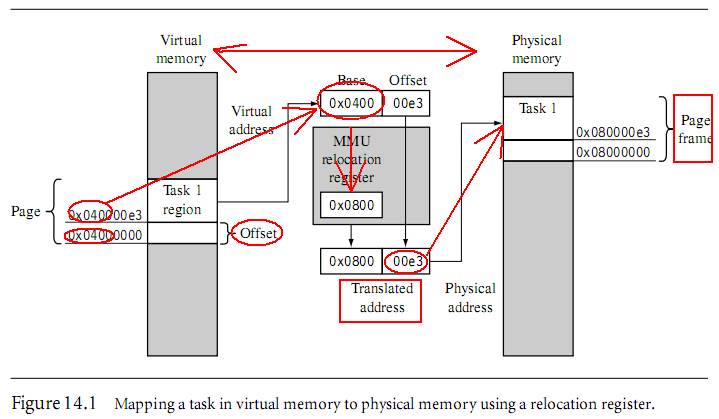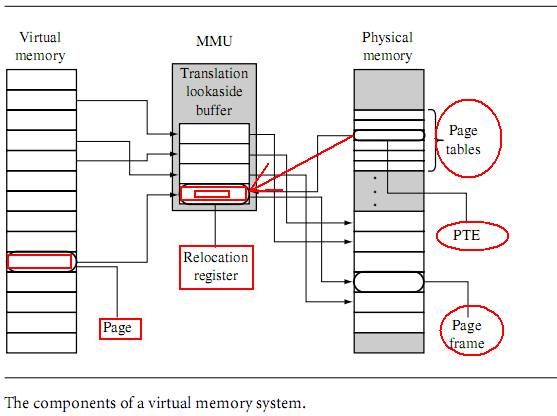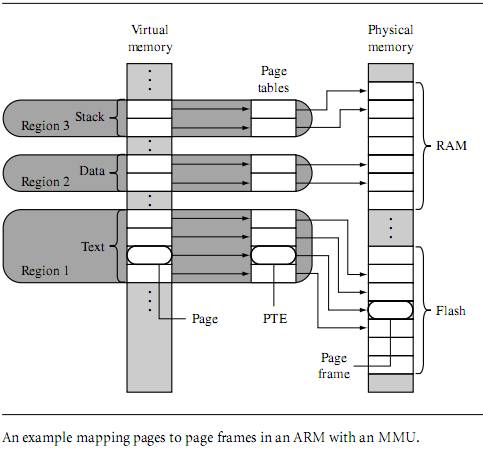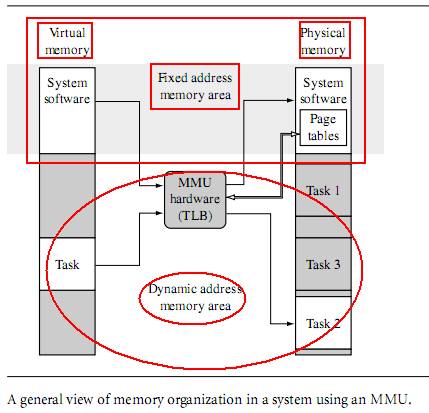——————————————————————————————————————————————
MMU的大名,早就听说了,可是一直不知道它是怎么工作的,前几月貌似看的模模糊糊,现在快年关了,来做个了结。在文中我会大量引用英文,并且不做翻译,因为俺觉得我的英文水平会误解别人。O(∩_∩)O哈哈~
One of the key services provided by an MMU is the ability to manage tasks as indepen-dent programs running in their own private memory space. A task written to run under the control of an operating system with an MMU does not need to know the memory
requirements of unrelated tasks. This simplifies the design requirements of individual tasks running under the control of an operating system.
——给每个任务提供独立的运行空间。
The MMU simplifies the programming of application tasks because it provides the resources needed to enable virtual memory—an additional memory space that is indepen-dent of the physical memory attached to the system. The MMU acts as a translator, which
converts the addresses of programs and data that are compiled to run in virtual memory to the actual physical addresses where the programs are stored in physical main memory.This translation process allows programs to run with the same virtual addresses while being
held in different locations in physical memory.——MMU作为一个转换器。程序可以运行在同一块虚拟内存,而各自存储在不同的物理内存。
We begin with a review of the protection features of an MPU and then present the additional features provided by an MMU. We introduce relocation registers, which hold the conversion data to translate virtual memory addresses to physical memory addresses,
and the Translation Lookaside Buffer (TLB), which is a cache of recent address relocations.We then explain the use of pages and page tables to configure the behavior of the relocation registers.
——这里介绍重定位寄存器,它保存转换虚拟地址到物理地址的数据;介绍旁路缓冲器(TLB),它是存放最近的的地址重定位信息的cache(高速缓存);介绍如是使用页和页表来重新配置重定位寄存器。
We then discuss how to create regions by configuring blocks of pages in virtualmemory .We end the overview of the MMU and its support of virtual memory by showing how tomanipulate the MMU and page tables to support multitasking.
——讨论通过虚拟内存中的块页表来配置来创建区域。最后演示使用虚拟内存来支持和创建多任务操作系统
___________________________________________________________________________
现在来看看这个MMU到底有什么东西,有什么特备的硬件结构

—————————————————————————————————————
To permit tasks to have their own virtual memory map, the MMU hardware performs address relocation, translating the memory address output by the processor core before it reaches main memory. The easiest way to understand the translation process is to imagine
a relocation register located in the MMU between the core and main memory.——地址重定位寄存器,其实就是地址转换器
Figure 14.1 shows an example of a task compiled to run at a starting address of 0x4000000 in virtual memory. The relocation register translates the virtual addresses ofTask 1 to physical addresses starting at 0x8000000.
A second task compiled to run at the same virtual address, in this case 0x400000, can be placed in physical memory at any other multiple of 0x10000 (64 KB) and mapped to 0x400000 simply by changing the value in the relocation register.
——为什么一定要是64KB为倍数的的地址的物理存储器上?难道这个是MMU有什么特殊的硬件结构决定了?
———————————————————————————————————
A single relocation register can only translate a single area of memory, which is set by
the number of bits in the offset portion of the virtual address. This area of virtual memory
is known as a page. The area of physical memory pointed to by the translation process is
known as a page frame.——页和页帧

———————————————上面虚拟内存的转换过程了———————————————
The set of relocation registers that temporarily store the translations in an ARM MMU
are really a fully associative cache of 64 relocation registers. This cache is known as a
Translation Lookaside Buffer (TLB). The TLB caches translations of recently accessed pages.
——重定位寄存器是由64个重定位寄存器cache相连成的,这个cache被称为旁路缓冲器(TLB),它缓存最近访问页转换的数据。——我觉得是地址数据才对,因为ARM9是数据总线和地址总线分离的。
In addition to having relocation registers, theMMUuses tables inmainmemory to store
the data describing the virtualmemorymaps used in the system. These tables of translation
data are known as page tables. An entry in a page table represents all the information needed
to translate a page in virtual memory to a page frame in physical memory.
——除了使用重定位寄存器外,MMU还使用在主存中的表来存放描述虚拟内存映射的数据,这个表被称为页表。
而页表的每个子表存储了一个页转换到物理存储器的一个页帧所需要的信息。
—————————————————————————————————
Apage table entry (PTE) in a page table contains the following information about a virtual
page: the physical base address used to translate the virtual page to the physical page frame,
the access permission assigned to the page, and the cache and write buffer configuration for
the page. If you refer to Table 14.1, you can see that most of the region configuration data
in an MPU is now held in a page table entry. This means access permission and cache and
write buffer behavior are controlled at a granularity(粒度) of the page size, which provides finer
control over the use of memory. Regions in an MMU are created in software by grouping
blocks of virtual pages in memory.——MMU区域由在内存中的虚拟页的块群以软件方法创建
___________________________________________________________________
Since a page in virtual memory has a corresponding (连续的)entry (条目)in a page table, a block of
virtual memory pages map to a set of sequential entries in a page table. Thus, a region can
be defined as a sequential set of page table entries. The location and size of a region can be
held in a software data structure while the actual translation data and attribute information
is held in the page tables.
Figure 14.3 shows an example of a single task that has three regions: one for text, one
for data, and a third to support the task stack. Each region in virtual memory is mapped
to different areas in physical memory. In the figure, the executable code is located in flash
memory, and the data and stack areas are located in RAM. This use of regions is typical of
operating systems that support sharing code between tasks.——操作系统就是这么设计的?
With the exception of the master level 1 (L1) page table, all page tables represent 1 MB
areas of virtual memory. If a region’s size is greater than 1 MB or crosses over the 1 MB
boundary addresses that separate page tables, then the description of a region must also
include a list of page tables. The page tables for a region will always be derived from
sequential page table entries in the master L1 page table. However, the locations of the L2
page tables in physical memory do not need to be located sequentially. Page table levels are
explained more fully in Section 14.4.
——难道在wince中的OEMAddresstable中的虚拟内存大小都是1M的倍数,且是连续
的是由此而来?(其实wince可以使用不连续的,不过要使用特殊技巧才行)
在物理内存中的页表可以是非连续的。——优龙的bootloader就有此见证!
看看下图

————————————————————————————————————————
MMU是如何实现多任务调度的?
——————————————
Page tables can reside inmemory and not bemapped toMMU hardware. One way to build
amultitasking system is to create separate sets of page tables, each mapping a unique virtual
memory space for a task. To activate a task, the set of page tables for the specific task and
its virtual memory space are mapped into use by theMMU. The other sets of inactive page
tables represent dormant tasks. This approach allows all tasks to remain resident in physical
memory and still be available immediately when a context switch occurs to activate it.
——页表可以驻留在内存中,不必映射到MMU硬件。构建多任务的一种方法是创建一批
独立的页表,每个映射到唯一的任务空间。为了激活某个任务,对应这个任务的那组页表
和其虚拟内存空间由MMU使用,没有激活的页表代表睡眠的任务。这种方法使所有的任务
可以驻留在内存中,当发生上下文切换的时候可以立即使用。
By activating different page tables during a context switch, it is possible to execute
multiple tasks with overlapping virtual addresses. The MMU can relocate the execution
address of a task without the need to move it in physical memory. The task’s physical
memory is simply mapped into virtual memory by activating and deactivating page tables.
——在上下文切换时候通过激活不同的页表,使得在重叠的虚拟地址执行多任务
成为可能。MMU可以通过重定位任务地址而不需要移动在内存中的任务。任务的
物理内存只是简单的通过激活与不激活页表来实现映射到虚拟内存
——My GOD!明白MMU的工作原理了!!!!!!!!!
——————————————————————————————————————
When the page tables are activated or deactivated, the virtual-to-physical address map-
pings change. Thus, accessing an address in virtual memory may suddenly translate to a
different address in physical memory after the activation of a page table. As mentioned in
Chapter 12, the ARM processor cores have a logical cache and store cached data in virtual
memory. When this translation occurs, the caches will likely contain invalid virtual data
from the old page table mapping. To ensure memory coherency, the caches may need
cleaning and flushing. The TLB may also need flushing because it will have cached old
translation data.——注意清理和清除cache哦
————————————————————
The effect of cleaning and flushing the caches and the TLB will slow system operation.
However, cleaning and flushing stale (陈旧的,过时的)code or data from cache and stale translated physical
addresses from the TLB keep the system from using invalid data and breaking.
——虽然清理和清除cache和TLB会导致系统运行变慢,但是清理和清除cache中过时的代码数据,
或者过时的物理地址,可以避免系统使用无效的数据而崩溃。
———————————————————————————————
During a context switch, page table data is not moved in physical memory; only pointers
to the locations of the page tables change.——任务切换如下步骤。
To switch between tasks requires the following steps:
1. Save the active task context and place the task in a dormant state.
2. Flush the caches; possibly clean the D-cache if using a writeback policy.
3. Flush the TLB to remove translations for the retiring task.
4. Configure the MMU to use new page tables translating the virtual memory execution
area to the awakening task’s location in physical memory.
5. Restore the context of the awakening task.
6. Resume execution of the restored task.
Note: to reduce the time it takes to perform a context switch, a writethrough cache
policy can be used in the ARM9 family. Cleaning the data cache can require hundreds of
writes to CP15 registers. By configuring the data cache to use a writethrough policy, there is
no need to clean the data cache during a context switch, which will provide better context
switch performance. Using a writethrough policy distributes these writes over the life of
the task. Although a writeback policy will provide better overall performance, it is simply
easier to write code for small embedded systems using a writethrough policy.
——使用文件系统的应该使用会写策略,这样效率较高。
++++++++++++++++++++++为什么虚拟内存和物理内存映射是要固定的?===========
Typically, page tables reside in an area of main memory where the virtual-to-physical
address mapping is fixed. By “fixed,” we mean data in a page table doesn’t change during
normal operation, as shown in Figure 14.5. This fixed area of memory also contains the
operating system kernel and other processes. The MMU, which includes the TLB shown
in Figure 14.5, is hardware that operates outside the virtual or physical memory space; its
function is to translate addresses between the two memory spaces.
——在运行系统时候不能改变两者的映射,否则很容易出错,wince是这样的,
不知道linux是怎么样的了,ADS 下的bootloader也是这样的。

————————————————方框的是固定映射————————————
参考资料
ARM System Developer's Guide: Designing and Optimizing System Software
——ARM System Developer's Guide: Designing and Optimizing System Software——ARM嵌入式系统开发:软件设计与优化的英文原版——我个人感觉这是国内翻译ARM书籍最好的一本之一,比杜XX的ARM体系结构与编程好千倍。 本书虽然说软件设计与优化,但是讲的硬件也很多,比如MMU和cache等,讲的精彩纷呈:我刚才想写关于MMU和cache的博客,发现太庞大,看来这段时间要重新看看这本书才能写。
下载地址:http://download.csdn.net/source/904273
ARM920T Technical Reference Manual——不多说了,想了解2440等的bootloader的人一定要看这个东西了,一些协处理器指令讲的很详细
下载地址:http://download.csdn.net/source/903240
ARM Architecture Reference Manual(2nd Edition) ——比较有价值的英文ARM书籍
下载地址http://download.csdn.net/source/901433
转载请标明:作者wogoyixikexie@gliet.桂林电子科技大学一系科协,原文地址:http://blog.csdn.net/gooogleman——如有错误,希望能够留言指出;如果你有更加好的方法,也请在博客后面留言,我会感激你的批评和分享。
























 2901
2901











 被折叠的 条评论
为什么被折叠?
被折叠的 条评论
为什么被折叠?








